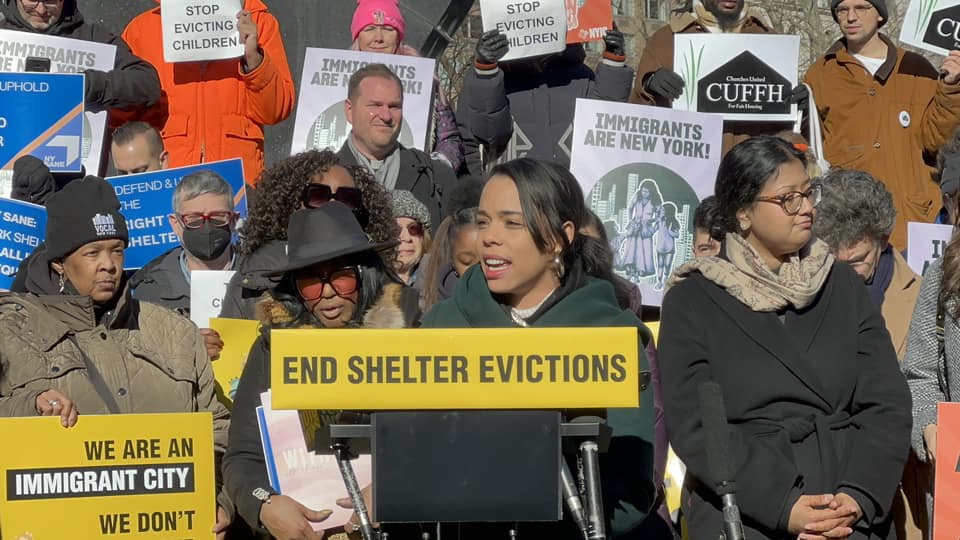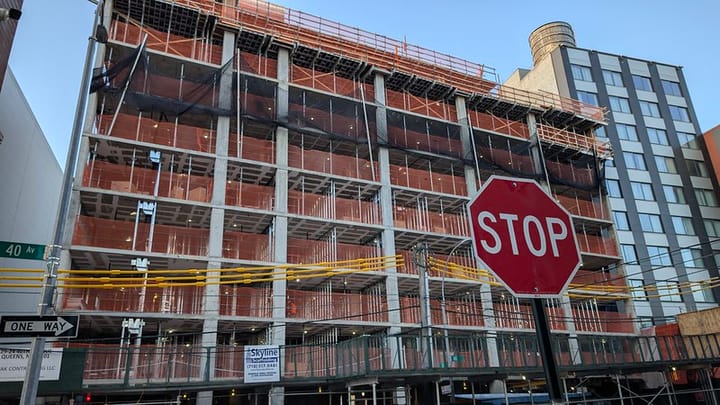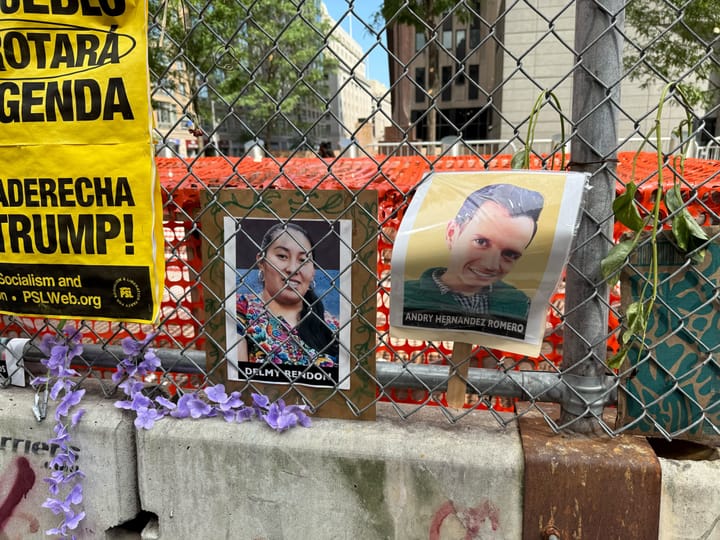What happened once the 'right to shelter' ended for asylum seekers
City data suggests that no one who qualifies for a bed is left waiting, something Legal Aid disputes.

Now that pro-Palestine protesters have given Eric Adams a new scapegoat on whom to blame the city’s ills, the migrant crisis narrative has somewhat receded from public view — and so have the city’s attempts to cut services for asylum seekers.
There’s been a significant paradigm shift in New Yorkers’ views on migration and the border in the two years since Texas started bussing thousands of asylum seekers to our city, spurred largely by Adams himself, who has repeatedly emphasized that New York can no longer handle the influx.
The backlash isn’t geographically or ideologically limited to Curtis Sliwa's efforts to block Flatbush Avenue in Marine Park to protest a migrant tent camp. Earlier this month, more than 200 Clinton Hill residents held a contentious meeting to discuss three migrant shelters in their neighborhood, which house a combined 4,000 people within a two-block radius. Residents described quality of life issues related to the shelter, including panhandling, excess trash and a rise in homelessness — but the fault clearly lies in the city’s policies, not with the migrants themselves.
Remember: Migrants can’t even apply for work permits until their asylum application has been pending for 150 days. Even so, in March, the city reached a deal with the Legal Aid Society in its persistent efforts to reverse aspects of the Callahan consent decree, the backbone of the right to shelter. Implementation began this month, with the city evicting single adult migrants from shelters after 30 days, or 60 days for migrants younger than 23, essentially formalizing an earlier policy that functionally did the same thing by forcing migrants to reapply for shelter in endless lines.
The city had also started limiting some migrant families’ stays in individual shelters to 60 days, requiring them to cycle from one facility to the next every two months. The city claimed these limits were intended to make families self-sufficient, even though local officials know there are significant barriers on asylum seekers’ ability to do so.
Under the settlement, the city is required to give Legal Aid a weekly report on the number of new arrivals under the care of various agencies involved in receiving them, separated into the categories of single adults, adult families and families with children. The reports also include weekly numbers of people entering and leaving city shelters and the number of people in hotel rooms booked in and outside New York City.
Despite some of the apocalyptic rhetoric predicting forever-ballooning shelter populations, Kathryn Kliff, a Legal Aid staff attorney on the Homeless Rights Projects said that entries and exits have remained more or less stable.
“The entrances are hovering, in the last few weeks, around 1,000 to 1,500 people a week, which is obviously a lot of people, but much lower than it was when they were getting 3,000 to 4,000 a week,” she told The Groove, adding that in some recent weeks, departures have even been higher than arrivals.
While the city has been sharing these numbers every week with Legal Aid, the data hasn’t always been particularly useful in parsing the city’s compliance and the dynamics on the ground, Kliff said.
“What is provided in the settlement doesn't actually reveal the full picture, which was not uncovered until they started providing it to us, and we’ve realized that what they were providing didn't reflect the reality for clients on the ground,” she said.
Specifically, the settlement directed the city to work through its backlog of people who had reapplied for shelter and been put on an enormous waitlist. The daily data include the highest waitlist number that was called that day and the number of days that this person had been waiting for a cot.
In a miraculous twist, the number of days someone has been waiting for a cot has been zero, according to what the city has told Legal Aid. For example, in the latest data, which Legal Aid provided to us, the highest waitlist number assigned a cot as of May 27 was 60,511. That person, and every single other person who had been the highest waitlist number for that week, was listed as having waited zero days for a cot. This suggests that no one who qualifies for a bed is left waiting, something Legal Aid unequivocally disputes.
“We know that that's not accurate, because we have clients who have waited more than that,” Kliff said.
It’s not necessarily that the city is lying or fudging the numbers, but instead that the waitlist numbers are arbitrary in a way where it’s possible that the highest waitlist number is given a bed and lower waitlist numbers are, for whatever reason, not.
In response to Legal Aid’s complaints, the city has begun providing what it calls supplemental data, which includes the number of people seen at the St. Brigid’s reapplication center per day, the number assigned a cot, and the number referred to a drop-in center, i.e. those who did not get a placement. This paints a worse picture of the city’s compliance with its requirement to give beds to people entitled to beds.
Overnight between this past Sunday to Monday, for example, a total of 189 “guests” did not receive a cot, of which 76 were referred to overnight sites like the Historic First Church of God and 113 left without a referral, either because they found somewhere else to go or decided to simply sleep on the street.
In conjunction with the city’s efforts to get people out of shelters, migrants who arrived a year ago likely have work permits by now, or will be getting them soon, allowing them to leave shelters out of ability rather than force. But the backlogs to actually get those permits are months — and sometimes upwards of a year — long, so continuing arrivals and the interminable delays at the federal U.S. Citizenship and Immigration Services mean that a lot of people are going to be left with no other options as they’re caught between authorization delays and the city’s efforts to get them out of shelter. When faced with no other options, we get stories such as migrants stacking up dozens to a room in commercial properties acting as makeshift shelters.
The shuffle extends outside of New York City too. This week, city officials said they’d soon be launching a resettlement program with the goal of getting migrants out of city-run hotel shelters and into apartments — in Buffalo, where about 2,000 migrants are currently living in New York City-funded shelters. Though this program won’t immediately reduce the number of migrants living in shelters here, officials say they hope it can be a blueprint for how to handle the flow of new arrivals. Elected officials elsewhere in the state have already said the program may be replicable in other cities, especially those whose populations have been declining in recent years.
Mayor Adams’s latest attempt to address the influx of migrants may end up simultaneously appeasing immigrant advocacy groups and New Yorkers who believe the city is overwhelmed by sheer number of asylum seekers. And unlike punitive measures like kicking migrants out of shelters, the resettlement program seems to be designed to help people get on their feet — though, of course, it’s too soon to say how it’ll turn out.




Comments ()